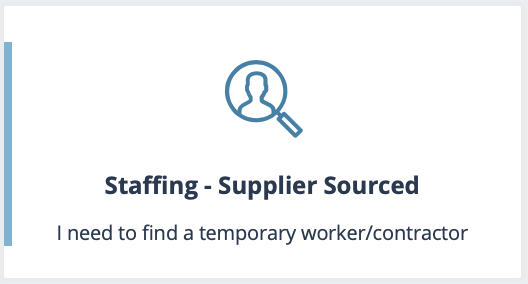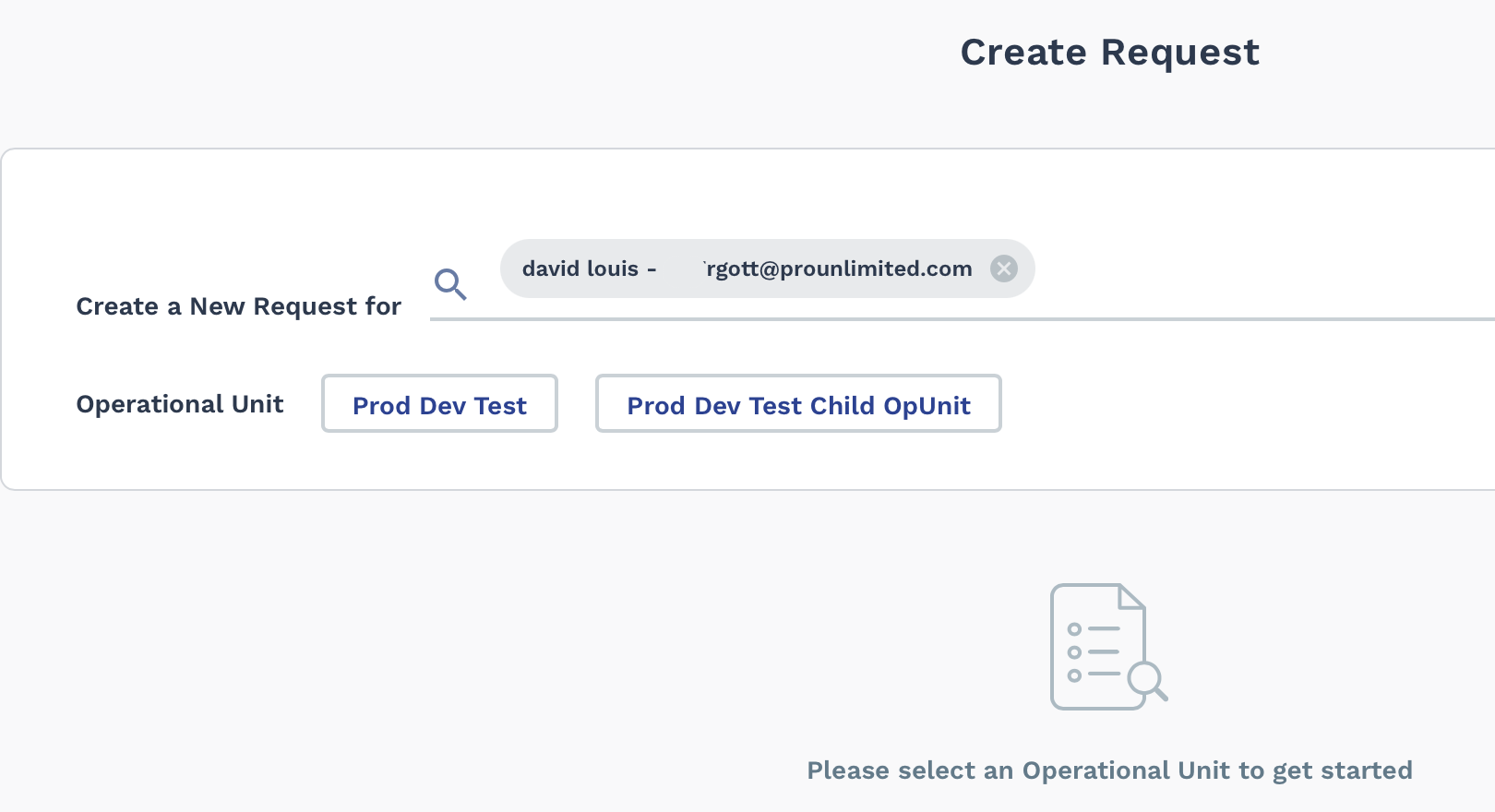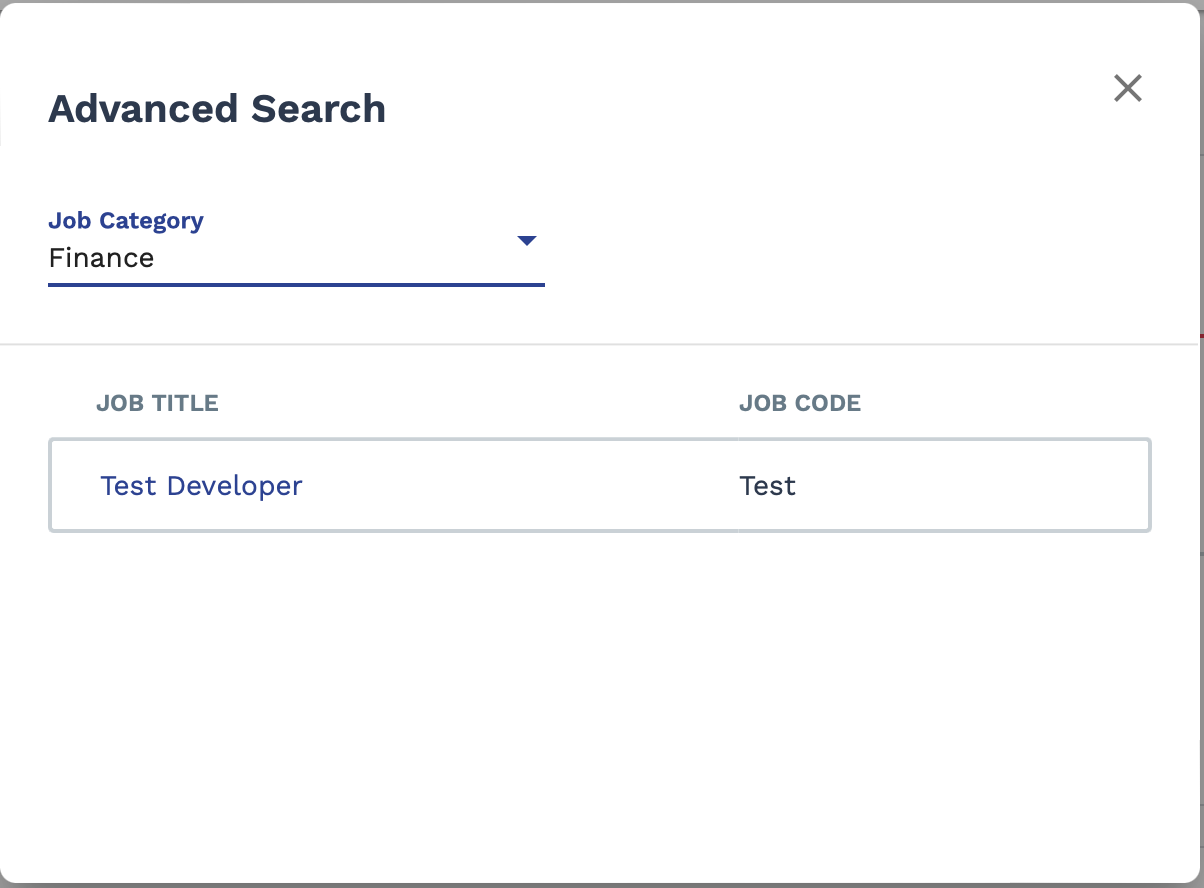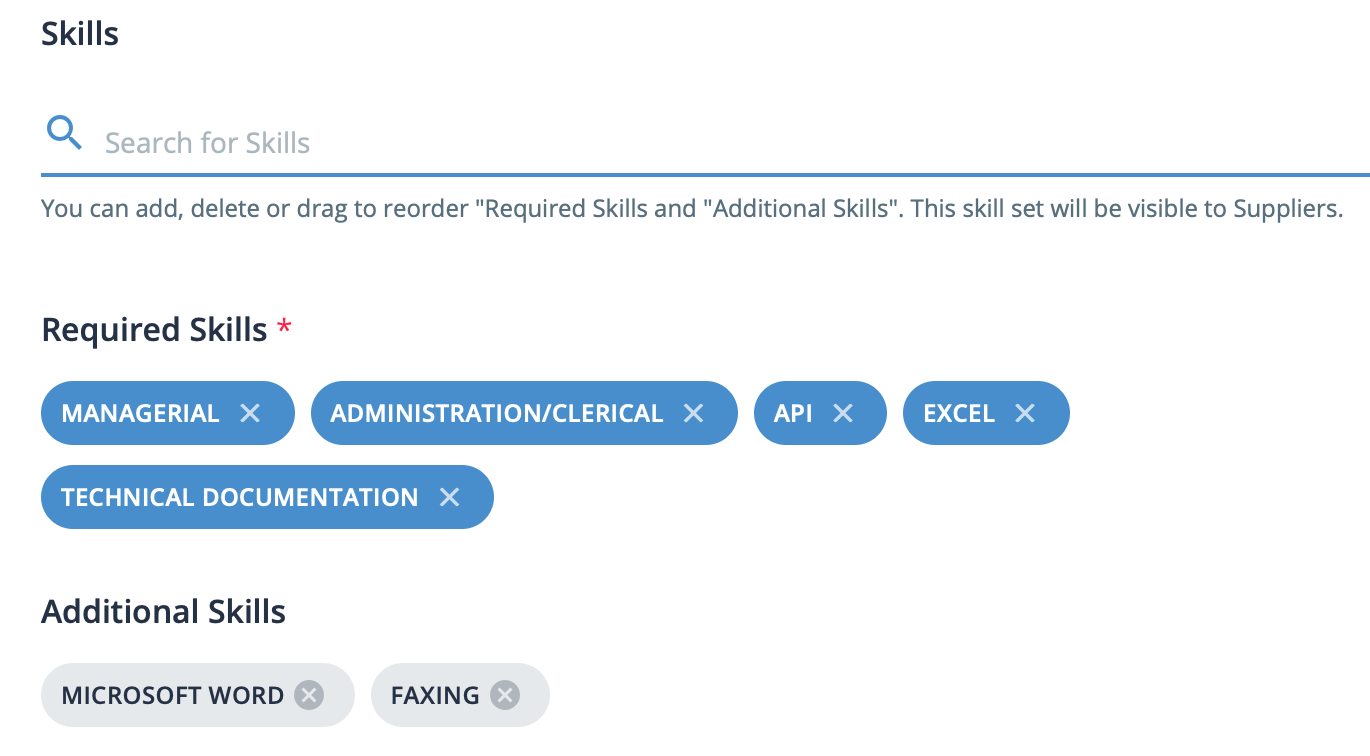Create Request - Staffing/Sourced
-
In the menu, click
 .
.
- Optional: If configured, select the operational unit for the staffing request.
-
On the Create Request page, click the
Staffing - Supplier Sourced tile.
 When you create a request, your name automatically is inserted as the hiring manager.
When you create a request, your name automatically is inserted as the hiring manager.
You can remove your name and use the search field to locate and insert a different hiring manager's name for the request. The application automatically suggests names that are configured for your client organization.
-
In the Job Details section, enter the job title.
The application automatically suggests job titles that are defined in the client organization, and are linked to a supplier in the supplier contract.

You can also click Advanced to search by category. The search pop up allows you to search by a category. Job Titles for each category can be clicked to populate the Job Title field.
 If you are self sourcing the job, that is, you know the person/people that are going to complete the work, you can fill in their information. For more information about this task, see Self Source a Position.Note:This task is different from a payroll request. Your ability to make payroll requests depends on the configuration of the client organization.
If you are self sourcing the job, that is, you know the person/people that are going to complete the work, you can fill in their information. For more information about this task, see Self Source a Position.Note:This task is different from a payroll request. Your ability to make payroll requests depends on the configuration of the client organization. -
In the Location field, enter the location where the job
is performed.
The application automatically suggests defined locations.Job locations are defined for your organization prior to request creation. If the job site is not a defined location, you can specify the details by a combination of country, state/province, and city. To enter this information, select the Work Completed Offsite check box, and using the drop downs, select the location details.
-
Optional: You can modify the defined job description if you have the correct
permissions. To modify the fields, click
 .
The permission required to edit the Job Description fields is defined by the Job Description Edit Access for MSP and Manager setting in the client organization's configuration. For more information about this setting, see Client Settings.If you have enabled the Job Description Upload functionality for the client organization, the following is added to this section:
.
The permission required to edit the Job Description fields is defined by the Job Description Edit Access for MSP and Manager setting in the client organization's configuration. For more information about this setting, see Client Settings.If you have enabled the Job Description Upload functionality for the client organization, the following is added to this section:
The application parses the uploaded file and replaces the skills information in the Skills section. To upload a file, click Upload New One, and select the file from your file browser.
This functionality requires that you enable the Talent Network or the Candidate Match functionality for the client organization. You also must enable the correct editing functionality for the MSP and client manager. For more information about this editing permission, see Client Settings.
-
Click
 .
.
-
In the Skills section, add at least one required skill
for the request.
Enter text in the search field to locate skills. The application automatically suggests skills. After you add skills, you can drag the tiles to recategorize as necessary.
 Note:This section is disabled/removed from the request creation workflow if the Ideal Experience feature is enabled.
Note:This section is disabled/removed from the request creation workflow if the Ideal Experience feature is enabled. -
On the Position Details page, in the Start
Date field, enter the start date for the job.
Note:This is the earliest date that a worker can enter time. This date is different from the date that the request is filled, converting it to an engagement.You can also click the calendar icon to open a calendar pop up that allows you to select the date.
-
In the End Date field, enter the end date for the
job.
Note:This is the last date that a worker can enter time.You can also click the calendar icon to open a calendar pop up that allows you to select the date.Note:Worker length of stay must conform to the worker tenure setting in the client organization configuration (). If the tenure exceeds this number of days for both requests and revisions, a warning is given. For more information about this setting, see Approval Settings.
-
In the Total Number of Positions field, enter the number
of workers required for the job.
This field defaults to '1'.
-
In the Time & Expense Approver field, enter the
billing approver for the job. This is the user in your organization that
approves time cards submitted by workers for the job.
Note:Approvers require the correct permissions for this role.This field defaults to the client manager filling out the request. You can enter and select another client manager if they have the correct permissions. For more information about the different client manager permissions, see Client User Permissions.
- In the Schedule section, use Full Time or Part Time button to define the engagement as full time or part time.
-
In the Hours Per Week field, enter the number of hours a
week required by the engagement.
If you select Part Time, enter values in the Hours Per Day and Hours Per Week fields. Optionally, you can select the required days per week from the drop down.The number of hours a week for a job is used to determine eligibility for a worker (overtime, thresholds, and so on) if configured for your client organization.If your client organization is using piece or multiple rates, the Full Time/Part time selector is disabled.
- Click the Add Schedule Notes link to open a text field for adding notes to the job schedule.
-
In the Reason for Hire section, from the
Reason drop down, select the hiring reason.
You can add reasons for a hire in the client organization's configuration. For more information about adding this task, see Add a Reason.
-
In the Financials section, from the
Currency drop down, select the currency
(denomination) for the request.
This setting determines how the financial values for the request are calculated. These values include the rates of pay for a worker, and the denomination of the values generated in reporting. The Total Estimate value at the bottom of the Financials section displays the calculated value in the selected currency.Note:Changing this value from one currency to another does not recalculate any financial values previously entered.
-
In the Bill Rate field, enter the job bill rate. If
configured for staffing requests, you can optionally enter a value in the
Pay Rate field.
Note:If you require that the client manager only has the ability to enter a pay rate, you can disable editing of the Bill Rate field (). For more information about this setting, see Manager Settings.These fields are dependant on each other and automatically calculate based on the fees and markup configured for your organization. If visible for staffing requests, you enter a value in one field, the other is automatically populated by the application.Fees and markups are defined for each category in the supplier contract. For more information about defining these values, see Supplier Agreements.If you have the Market Rate Module activated, the market low rate, the proposed rate, and the market high rate is displayed. This can be either the bill rate for the job title, or the pay rate for the job title, depending on the module configuration.
 You can restrict edit access for the bill rate. For more information about this configuration, see Manager Settings.
You can restrict edit access for the bill rate. For more information about this configuration, see Manager Settings. -
Optional: If enabled, you can click Show Additional Cost
Estimations to input values to further calculate the bill
rate.
These fields are used to calculate any additional funding and include that funding for approval. For more information about these fields, see Additional Cost Estimation Fields.Advanced calculations are enabled in the client organization's configuration. For more information about this setting, see Client Settings.
-
In the Select Department section, from the
Department drop down, select the department for the
engagement.
Only departments that are assigned to the Time & Expense Approver display in the drop down. You can configure the client organization to allow client managers to add departments that can be selected in this drop down. For more information about this setting, see Manager Settings.
-
Click
 .
.
-
In the Sourcing section (Supplier
tab), you can view configured suppliers for the request.
The available suppliers appear in the Suppliers table (Suppliers tab). If enabled for the client organization, the tables editable. You client manager configuring the request can select the check boxes for the suppliers that they want to notify for the request. The client manager can additionally review the selected suppliers by clicking the Show Only Selected Suppliers check boxing the Suppliers table header.
If a supplier does not appear in the table, if enabled, the client manager can request that a supplier be added to the request. This action opens a configuration panel to add the supplier's contact information (Name and Email fields).
You can add request additional suppliers by clicking
The add new supplier not shown and modification of the supplier list are enabled in the client organization's configuration. For more information about these settings, see Client Settings. .
. -
Click
 .
.
-
If configured, enter additional information on the Additional
Information page. This page might be disabled by an
administrator.
Client managers with view/edit permission can upload files to a request and make the file visible to suppliers or not. This is a file level setting at the request level. If the client organization is configured to hide all files from suppliers (), then this setting is disabled by default and cannot be modified. See Client Settings.
You can restrict the options in this field. Enable the ). Enabling this setting converts the free text entry field to a suggestive search that only displays configured client manager users from the organization. See Client Settings.
- Review the request information and edit if required.
-
Click
 .
.